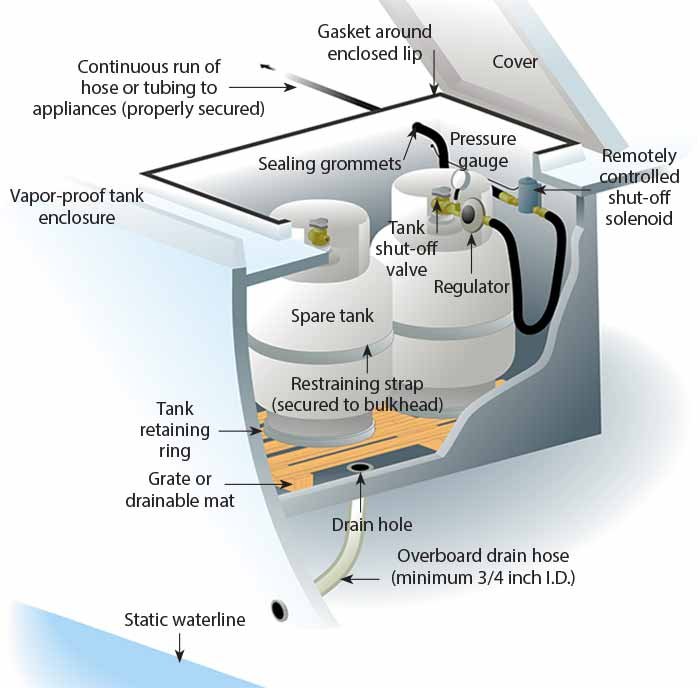
HOW TO HANDLE PROPANE ON A BOAT
Here’s a great article by Mark Corke about Propane handling.
Propane is heavier than air, which means any escaping gas can end up in your bilge. The results could be deadly.
A locker for propane should contain the cylinders, often called bottles, properly secured, and nothing else Note the drainpipe to safely vent spilled gas overboard away from the boat interior. (Illustration: ©2018 Mirto Art Studio) .
Propane (also knowns as LPG) is a great fuel for heating and cooking aboard. It has a high calorific value, meaning it produces a lot of energy for its weight; it comes in handy cylinders; and is readily available. What’s not to love?
Not much! But propane does have one flaw — it’s heavier than air. This means that any escaping gas from a cylinder, gas line, or faulty appliance will sink to the lowest point it can find, often unnoticed. Because a boat is a confined structure, any leaking propane is likely to end up in the bilge. If enough collects, an explosion from a stray spark is a distinct possibility. While fortunately not common, the BoatUS Marine Insurance files contain numerous claims for propane explosions, which often result in serious injuries. This is another reason, if you needed reminding, for having ignition-protected electrical equipment. Ignition-protected equipment, such as starter motors and alternators, is safe for gasoline-powered engine spaces because they will not produce a spark when operating — one reason why most automotive electrical equipment, often not ignition-protected, is unsuitable for use afloat.
Problems are rare when sensible precautions are practiced in storing and using propane. But as our claims files show, things do go wrong, often with little or no warning, and the results can be tragic. To avoid problems, it’s critical that propane is stored and used correctly. The American Boat & Yacht Council (ABYC) has strict guidelines as to how any propane system is installed on a boat.
Cylinder Storage
Whether in use or spares, cylinders should be contained in an approved storage locker. Any locker must be above the normal level waterline of the boat, it should drain any leaking gas to atmosphere, and it must not allow any escape of gas to find its way into the interior of the boat. The gas locker should be used for the sole purpose of storing gas cylinders and no other equipment.
ABYC also specifies that the locker be constructed, or lined, with corrosion-resistant materials. Fiberglass is an almost perfect material for any such locker. Additionally, any gas locker must only be able to be opened from the top and have a latch so that it can be properly sealed closed, although the latch should not require tools to be opened. Finally, because propane is heavier than air, any locker must have a drain at its lowest point that leads over the side so that leaked gas is safely vented away.
Even if a cylinder that is in use is stored properly, all too often we see spare bottles simply tossed into a locker. Not only can these spare cylinders become damaged with the movement of the boat and gear, but should the valve be dislodged or gas escape for some other reason, it likely has nowhere to go except into the boat’s bilge.